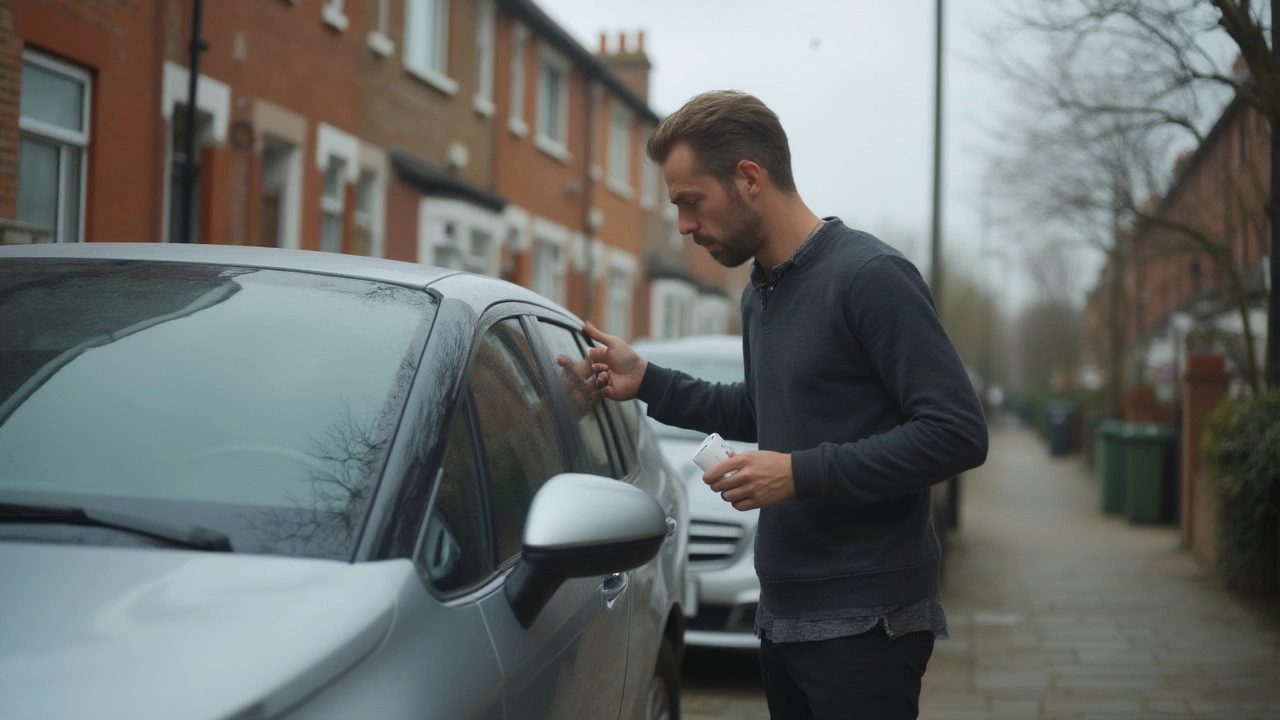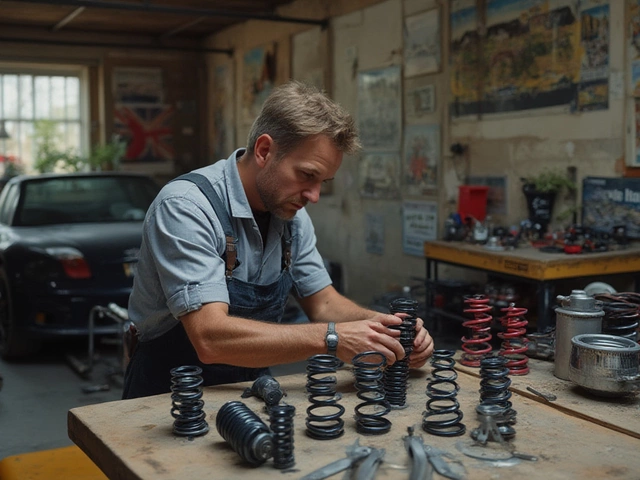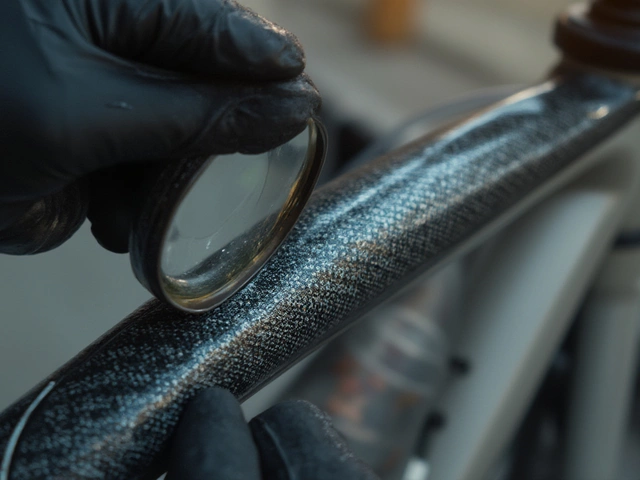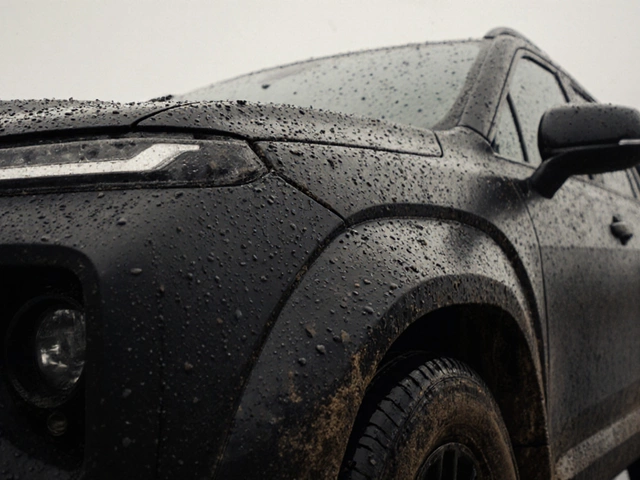Ever stood in the parking lot staring at a new scuff or scratch on your car, knuckles white, cursing the shopping cart gods? You start thinking of hacks you’ve seen online—people say Magic Eraser makes car scratches disappear. It sounds easy and cheap compared to $600 for a pro paint correction. But does it actually work, or is it a disaster waiting to happen?
How Does a Magic Eraser Work?
Magic Erasers seem like plain, white foam on the outside, but they’re actually made from melamine foam, a structure that turns hard and tiny when manufactured. Imagine sandpaper, but made out of a fine sponge. It’s full of minuscule open cells, so when you scrub, these act like microscopic grit lifting stubborn dirt or marks with each swipe.
People use them to erase pen on walls, scuffs from sneakers, sticky residue, or build-up on stove tops. Car forums are full of drivers swearing by them for cleaning up interior plastics and the occasional gray bumper mark. This is because Magic Erasers don’t just clean—they actually abrade, physically removing a thin layer from the surface. Melamine foam’s microstructure makes it more abrasive than it feels in your hand, which is perfect for hard plastics or walls, but raises red flags once you’re near car paint.
According to Mr. Clean’s own product Q&A, their eraser is “not recommended for use on glossy or delicate surfaces, such as car paint.” Why do people risk it? Because when you see a scuff mark rubbing off, it’s satisfying stuff. Here’s the catch: the same abrasive action that makes it powerful as a cleaner can slice right through your car’s clear coat. And that clear coat is your car’s sunscreen—it protects paint from oxidation, fading, and every bird dropping the summer throws at you.
If you look at Magic Eraser under a 150x microscope, it looks like a warped forest of resin pillars with gaps between—each gap is a tiny bite, and in the context of paint, those bites don’t heal by themselves. The keyword for any use on a car should be caution, especially on visible, painted surfaces.
Magic Eraser vs. Real Car Scratches: What Really Happens?
Most “scratches” on cars fall into two camps: light surface marks that don’t go beyond clear coat (think: transfer from another car, or a poorly parked bike rubbing by) and deeper scratches that score into color or primer layers. Magic Eraser can sometimes help with one, but not the other.
If the mark is actually a “scuff”—meaning it’s a foreign substance (like paint transfer or a rubber streak) stuck atop your clear coat—a Magic Eraser might remove it. This isn’t technically fixing a scratch; you’re just scrubbing off the other material. You might see the white foam pick up some of the black or red scuff as you wipe. But if the actual surface is cut, even a little, Magic Eraser won’t fill it in, it just blurs the edges by dulling everything around it—including the clear coat. Some drivers see that and think the scratch disappeared, but under good lighting the spot might just look matted, or faded—because you basically sanded the shine right off.
For real scratches—those that dig past the clear—Magic Eraser does nothing useful. You can flatten sharp edges a little, but you’ll likely leave hazy streaks around the area. And because melamine foam can remove your car’s UV protection, there’s the risk of damage spreading, which only shows up months later as spots that don’t match the rest of the paint.
| Type of Mark/Scratch | Will Magic Eraser Work? | Risk of Damage |
|---|---|---|
| Paint Transfer/Scuff | Yes (removes transfer, not true scratch) | Low to Moderate |
| Light Clear Coat Scratch | Sometimes (may reduce, but dulls finish) | Moderate to High |
| Deeper Paint Scratch | No (can worsen appearance) | High (exposes paint, causes hazing) |
The fact is that melamine foam is rated at around 3000 grit—similar to ultra-fine sandpaper. While that might not sound dangerous, car clear coats tend to be about as thick as a Post-It note. Abrading away even a fraction leaves the paint below more vulnerable, and modern cars (since the 2000s) have notoriously thin clear coats due to environmental regulations. By comparison, most pro detailers use polishes and compounds with much finer grits, paired with gentle pads, to shave off microns at a time rather than sanding an entire patch.
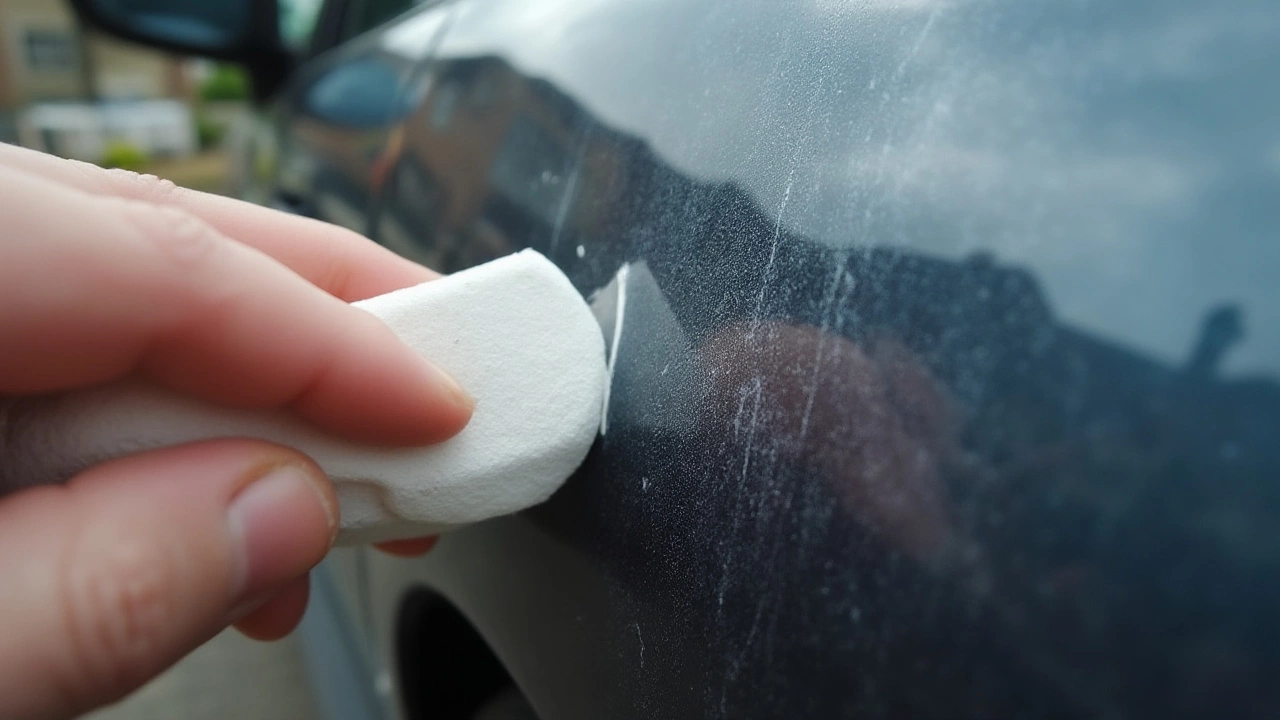
The Right Way to Use Magic Erasers on Your Car
The best advice you’ll get for using Magic Eraser on your car: treat it as a last resort—and never on paint unless you’re ready for follow-up repair. Still determined to try? Here’s how to minimize risk:
- Test first. Always start on an out-of-sight spot—like a lower rocker panel or inside the trunk lip—to see how your paint reacts. Not all clear coats respond the same way. Some soft Japanese paints dull or haze with just a couple swipes.
- Wet the eraser thoroughly. A dry Magic Eraser acts like an aggressive sanding block. Soak it and squeeze out excess (but not to full dryness). This helps buffer the abrasive action. Never use it dry on any painted surface.
- Use gentle, straight-line strokes—no aggressive circling or pressure. Think feather touch. You’re not scrubbing a pot, you’re barely brushing a baby’s cheek.
- Stop immediately if you notice the cloth picking up paint color, or if the area loses its shine. Damage can’t be undone without more work. Wipe off residue and inspect in good lighting before continuing.
- Follow with polish and wax. Even if the eraser ‘fixes’ a mark, you’ll likely leave micro-abrasions. Use a swirl remover or polish designed for automotive paint, then wax immediately to restore lost protection.
Honestly, the only places Magic Erasers truly shine on cars are on tough interior plastics (think dirt and shoe stains on door pockets), steering wheels, or rubbery areas like side mirrors—not shiny panels. They work wonders on textured, unpainted trim, but keep them far from instrument clusters or high-gloss pieces. Several pro detailers insist the best interior cleaning uses Magic Eraser with an all-purpose cleaner, but only for durable surfaces. Never use on navigation screens or piano black finishes—it’ll cloud or scratch instantly.
What Do the Pros and Testers Say?
No major car care brand recommends Magic Erasers for paint, and most pro detailers avoid them unless desperate. In 2023, Consumer Reports and Car and Driver both published small experiments: they found that while Magic Erasers made quick work of scuffs, they consistently left visible dull spots even on newer clear coats with just a few passes. One enthusiast blog documented using Magic Eraser on a 3-year-old Accord’s rear bumper scrape, showing a before-and-after under bright sunlight. The paint was clean but obviously clouded, and close-up shots revealed hazing that had to be fixed with two stages of polishing.
Ask around detailing forums and you’ll hear this refrain: “Great for shoes, terrible for paint.” Plenty of detailers admit to using them for quick scuff removal in dealership settings—especially black plastic bumpers or wheel arches—where speed matters more than perfection. But they’re always followed up with polish and often a silicone treatment to hide dullness. The thing is, you never know if your paint will react worse than tested cars. Some European paints harden up well; American and Japanese compacts can be soft as butter, especially in humid climates.
One weird tip: Magic Erasers work decently at removing stubborn bug guts or tar from windshields—just not the painted surrounds. They’ll even revive faded white-wall tires, according to roadside detailers in Texas, as long as you rinse thoroughly after. But for regular old car paint scratches, pro shops recommend products formulated just for that job—like scratch removers (Meguiar’s, Turtle Wax, 3M), or polishing compounds used with soft applicators.
As for DIY fixes, it’s safer to start gentle. Try a bit of car soap and a proper microfiber cloth for paint transfer. If it won’t budge, move to a clay bar or specific paint-safe products. Save the Magic Eraser for the last resort—or, better, just for the inside surfaces you know it won’t hurt.
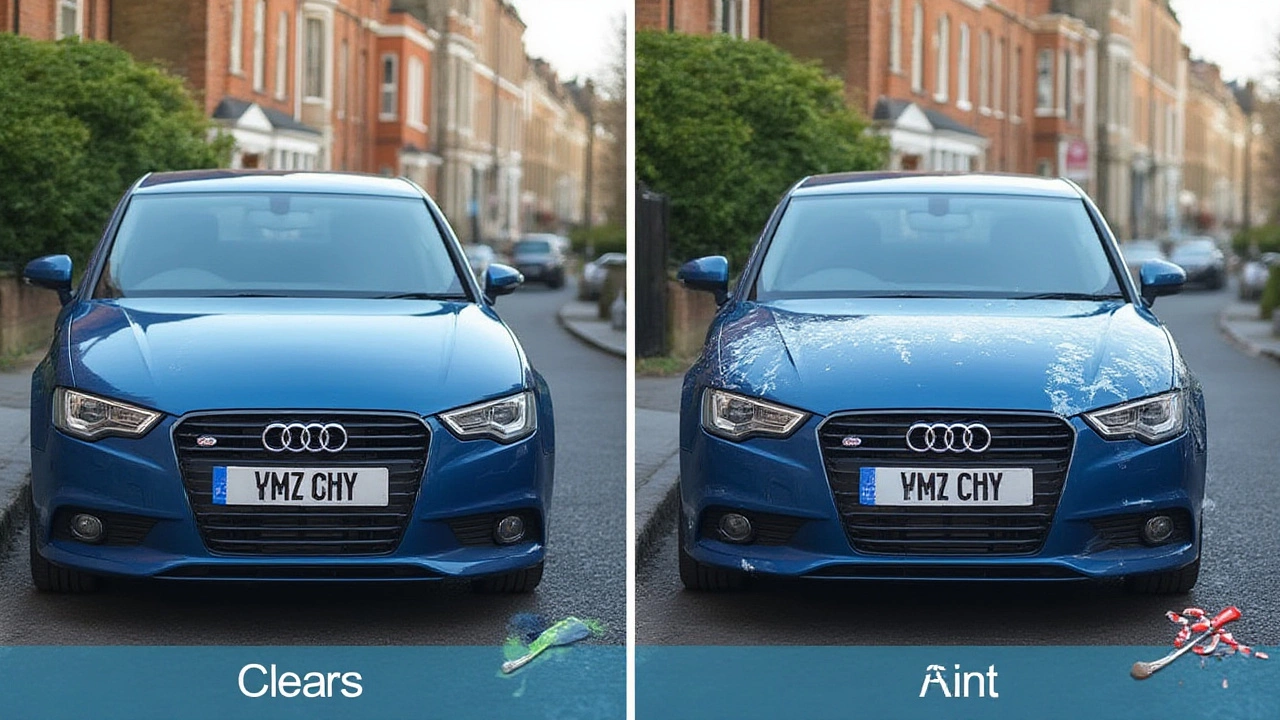
Safer Alternatives for Removing Car Scratches and Scuffs
Before you reach for a Magic Eraser out of frustration, know you’ve got other options that give better results without risk. For scuffs that are really just paint from another object stuck to your car, a detailing clay bar is best. You use it with a lubricant, and it’ll pick up just the transfer without sanding the clear coat. Most retail kits come with a small clay bar and a bottle of spray, and the results are usually dramatic. Drivers dealing with light scratches can try over-the-counter scratch removers, which use mild abrasives paired with fillers. They don’t cause damage if you keep pressure light. Popular scratch removers from Meguiar’s and 3M are everywhere for a reason—they’re easy, safe, and won’t dull if you follow instructions.
- Clay bar with lube: Perfect for superficial marks and scuffs, doesn’t harm clear coat, widely available.
- Polishing compound (ultra-fine): Will reduce the appearance of light scratches. Applied in straight lines with a microfiber pad.
- Professional machine polish: The ultimate fix for tricky clear coat scratches, but not cheap. Detailed shops use this for a reason.
- Shoe polish test: Run a darker wax over the scratch—the lighter the mark, the quicker you can fix it at home. Deep marks usually need pro paint work anyway.
Ever use toothpaste for scratches? It’s a trick that works in a pinch if you’ve got minor marks, because toothpaste acts like a super-fine abrasive (think 5000-7000 grit). Not as risky as Magic Eraser, but again, always test first. Finish up with polish and wax to seal in the correction.
Some owners find the old pencil-eraser trick works for tiny paint transfers—but they’re also gentle, much softer than melamine foam. DIY touch-up pens are best left for chips, not scratches, but can fill deeper gouges to some degree. If you see metal, or the color layer, you’re best off going to a pro—anything you do at home won’t stop rust or further fading.
The rule is this: if you’re not sure whether it’s just transfer, or a real scratch, clean the area first and inspect under natural light. If it catches your fingernail, it’s too deep for any eraser. For anything else, reach for the safest, car-specific product you can. Your wallet (and your car’s paint job) will thank you.
In case you’re a data junkie, here’s a quick rundown on average clear coat thickness, Magic Eraser grit, and the cost of pro scratch removal:
| Item | Typical Measurement/Cost |
|---|---|
| Average car clear coat thickness | 30-50 microns (0.03-0.05mm) |
| Magic Eraser abrasive (melamine foam) | ~3000 grit equivalent |
| Clay bar kit price | $10-$25 (retail) |
| Professional scratch repair cost | $60-$600 (varies by depth/area) |
So, can you use a Magic Eraser on car scratches? Sure, if you’re careful and the mark is really just a transfer, not an actual cut into the paint. But trust me, you’ve got better, safer ways to make your car look new—ways that don’t risk swapping one blemish for another. Save those magical sponges for walls, stoves, and rubber trim. When it comes to your ride, the best fixes usually aren’t the fastest.

